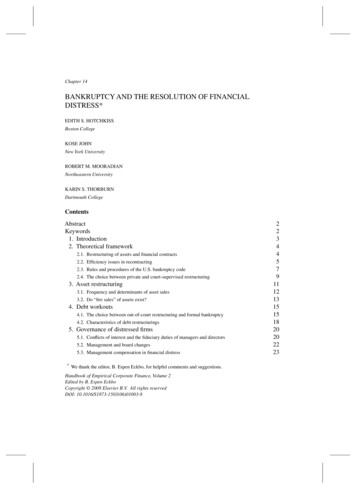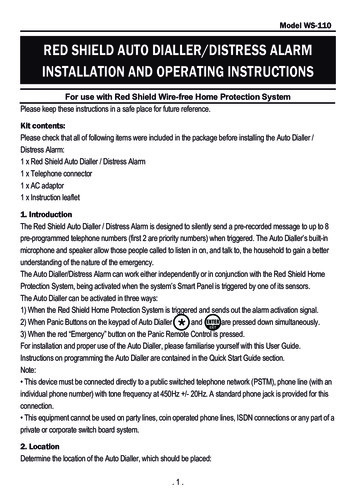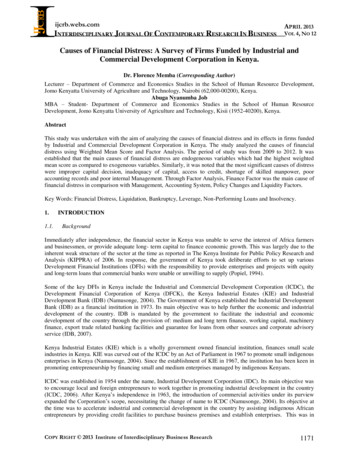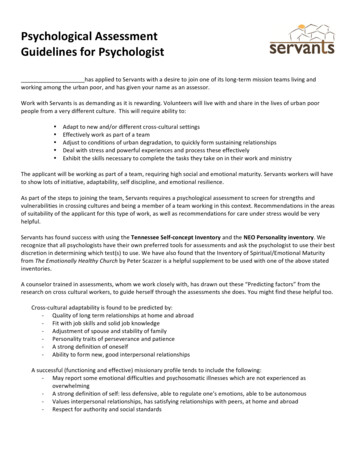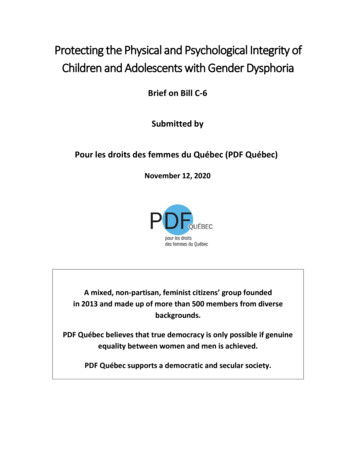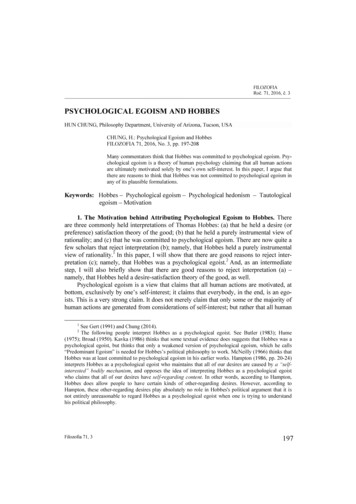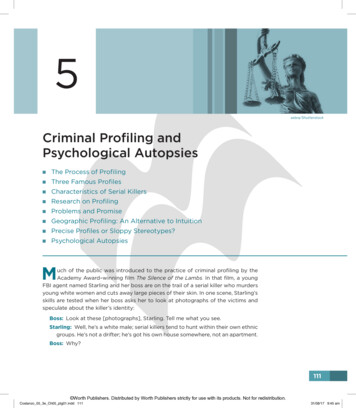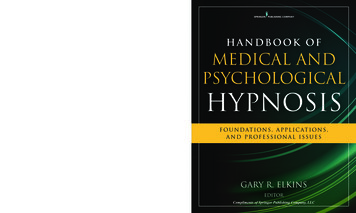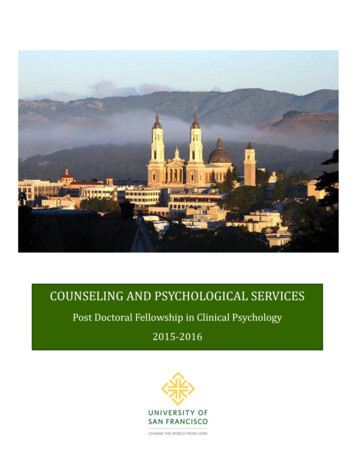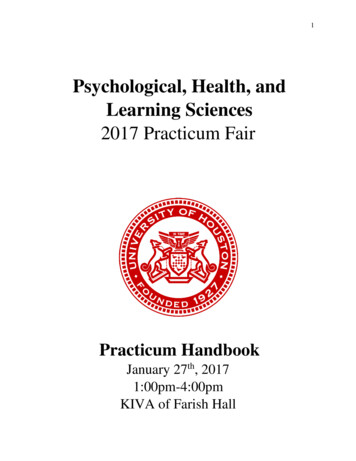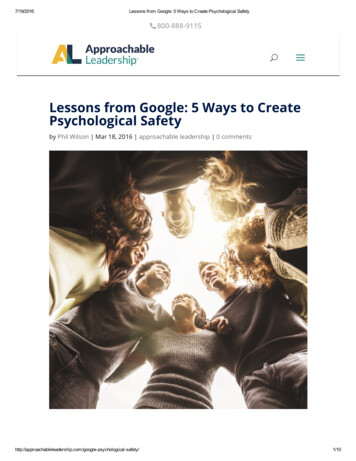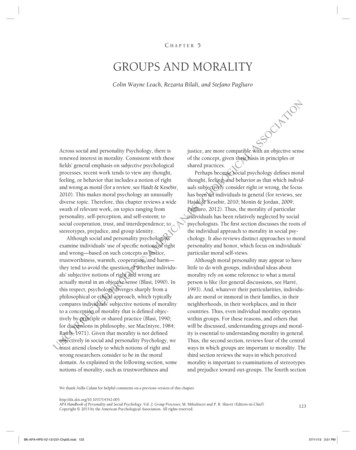
Transcription
ISSN 1803-4330peer-reviewed journal for health professionsvolume V/2 October 2012Spiritual and Psychological Distress in Patients with DepressionIvan FarskýDepartment of Nursing, Jessenius Faculty of Medicine in Martin, Comenius University in BratislavaABSTRACTObjectives: The study aimed to assess spiritual distress in patients with major depressive disorder and to identifythe relationship between spiritual distress and mental distress.Methods: Spiritual distress was evaluated using The Meaning in Life Scale and Existential Well-Being, a subscaleof the Spiritual Well-Being Scale. Mental distress was assessed with the SCL 90 questionnaire.Results: The study established that patients with depression are at a risk of experiencing spiritual distress. Wefound numerous negative significant relationships between the variables of spiritual distress and the dimensionsof psychological distress. Increased spiritual anguish was associated with increased mental distress.Conclusion: Despite its absence from nursing plans, spiritual distress is a serious problem, which, for instance,intensifies mental problems in patients with depression. The inadequate diagnostics and approach to the diagnosisreduce the quality of nursing care.KEY WORDSspiritual distress, depression, psychological distressINTRODUCTIONMajor depressive disorder is one of the most seriouspsychiatric diseases. Apart from the adverse somatic,psychological, and social impacts it also affects the spiritual well-being. It is often associated with feelings ofloss of control, hopelessness, guilt, lack of life meaning.As stated by Roberts (2000, p 435), mental disorderrepresents a “crisis of a sense of meaning and purpose.”Individuals with mental problems experience feelingsand thoughts that are troubling for themselves as wellas their surroundings. They struggle to find a sense andmeaning in their unusual experience, which are essential for reaching their mental balance (Smale, 2000).All these problems are included in NANDA-I diagnosis Spiritual Distress, which defines SD as a reducedability of an individual to experience and integrate themeaning and purpose of life through a connection withoneself, others, art, nature and/or a higher force thattranscends the person (NANDA, 2009, p 208). Thediagnosis is missing from nursing documentation despite the consequences that spiritual distress has. AsNemčeková (2004, p 672) states: “An existential crisis,even a temporary one, is the most serious form of degradation of the quality of life; other problems as partialand relatively more easy to solve.”OBJECTIVESThe study focuses on assessment of spiritual distressin patients with depression. Another objective was toidentify the connection between the perception of spiritual distress and mental distress.PARTICIPANTSThe research sample consisted of 109 patients withmajor depressive disorder (mean age: 43.4 11.8), ofwhom 48 were men and 61 were women. The inclusioncriteria were: a diagnosed and treated mental disorder of the depressive type, informed consent, patientcooperation, aged 18 and older. The exclusion criteriaincluded a medium-severe to severe cognitive impairment (based on a psychiatric assessment), communication disorder, acute mental disorder, acute somaticdisease, severe chronic somatic disease.The participants were patients hospitalized at thePsychiatric Clinic, Jessenius Faculty of Medicine inMartin, Comenius University, recovering from an acutestage of the disease.ISSN 1803-4330 volume V/2 October 20121
METHODSa) Spiritual/Existential DistressThe selection of methods was based on the fact thatalthough NANDA I defines spiritual distress, it doesnot mention any specific tools for its assessment.As the core of the definition is the meaning andpurpose of life, we decided to measure them withan instrument that measures the sense of purposein life and with Existential Well-Being, a subscale ofthe Spiritual Well-Being Scale. A low sense of purpose in life and low rates of existential well-beingare symptoms of spiritual distress.The Meaning in Life Scale – MLS (Halama, 2002,p 265). The scale is based on a three-component understanding of life’s meaning. The cognitive dimension (MLSC) includes items concerning the overalllife philosophy, direction, understanding or missionin life. The motivation dimension (MLSM) consistsof items relating to goals, plans, and the strengthand endurance the individual exerts to realize them.The affective dimension (MLSA) of the meaning oflife comprises items relating to life satisfaction, fulfilment, optimism, or, on the negative level, feelings of disgust, monotony, etc. The scale features18 statements, with 6 on each subscale. The itemsare rated on a 5-point Likert scale from 1 – stronglydisagree to 5 – strongly agree, based on the participant’s agreement with the statements. Scores evaluated include the subscale score that ranges from 6 to30 and the total score, which ranges from 18 to 90.Higher scores indicate a higher sense of purpose inlife of the respondent.Existential Well-Being (SWSE) – a subscale of theSpiritual Well-Being Scale (Ellison, 1983). Existential well-being constitutes a “horizontal” dimensionof spirituality, which focuses on how well the personis adjusted to self, community, and surroundings.This subscale includes the existential notions of lifepurpose, life satisfaction, and positive and negativelife experiences. The subscale has 10 items rated ona 6-point Likert scale, where respondents expressto what degree they agree with the statement, from1 – strongly agree to 6 – strongly disagree. Scoresrange from 10 to 60. The higher the spiritual wellbeing is, the higher the score.b) Psychological DistressPsychological distress was assessed using the toolSymptom Checklist 90 (SCL-90) (Baštecký, Šavlík,Šimek, 1990). This self-report assessment scale targeted at monitoring the intensity of the occurrenceof subjective psychological and behavioural symptoms. SCL-90 measures the current (point-in-time)mental condition, and not the permanent featuresof personality. SCL-90 contains 90 items that aregrouped into nine dimensions: somatization (So),obsessive-compulsive (OC), interpersonal sensitivity (IS), depression (De), anxiety (An), hostility(Ho), phobic anxiety (PA), paranoid ideation (Pa),psychoticism (Ps) unclassified items (UI) – withthe view to covering the full symptomatic behaviourin patients. In addition to the dimensions, the GSI(General Symptomatic Index) – the total index ofsymptoms, and the PSDI (Positive Symptom Distress Index) – the average intensity of symptoms,were evaluated.The generated data were processed in the programmeStatistica v.7. Relationships between variables wereidentified with the help of descriptive statistics anda nonparametric test (Spearman’s rank correlation coefficient).RESULTSPatients attributed the highest score to the cognitivedimension of the meaning (Table 1).The highest number of mental problems in patientswith depression was found in the dimensions of depression and obsessive compulsion and the lowest numberin psychoticism and hostility (Table 2).Every spiritual variable correlated with at least5 dimensions of psychological distress and all correlated significantly with the General Symptomatic Index (GSI), as well as the intensity of symptoms (PSDI)(Table 3).DISCUSSIONThe sense of purpose in life in patients with depressionscored about 60% and existential well-being 52% of themaximum score. Farský (2011, p 60) argued that in hissample of 249 adult respondents without any mentaldisorders, the sense of purpose in life was at 75% of thepossible maximum and existential well-being at 66%on average.Similar results in a healthy population are also reported by Halama et al. (2010, p 50), where the meaning of life was at about 74% and existential well-beingat 67%. The study established that patients with depression are at a risk of experiencing spiritual distress.Our findings are only confirmed by the results of otherstudies (Mascaro, Rosen, 2005, p 1003; Ondrejka, 2006;Farský, 2008; Halama et al., 2010).The assessment of the relationship between the variables of spiritual distress showed multiple negative significant correlations. The cognitive dimension of lifemeaning was the highest correlated variable (except thegeneral sense of purpose). As mentioned in the results,ISSN 1803-4330 volume V/2 October 20122
depression at the second period, the purpose of life atthe first measurement was another factor which canexplain to a certain degree the residual variance. Thelevel of life’s meaning may thus be seen as a rather independent clinical phenomenon. Likewise, it is possiblethat high rates of psychopathology decrease the rateof life-meaning, as already indicated by Yalom (2006).He pointed out that the purpose in life rises with thedecrease in levels of psychopathology, even in thecase of a biologically-based intervention. In contrast,SCL-90 measures the current (point-in-time) mentalcondition, a less permanent variable in terms of time.Consequently, experiencing a spiritual distress or wellbeing is likely to affect psychological distress, and notvice versa. The use of spirituality as a coping mechanism belongs to the described effects of spirituality onmental health. Yi et al. (2006, p 24) note that higherlevels of spiritual well-being may enhance positive and“healthier” personal and social behaviours, provide anumbrella and unifying framework that helps the personsolve unexpected and problematic situations, and maygive a greater sense of coherence between the personand their environment; all this may provide protectionagainst depression and other mental health problems.The relationship between spiritual variables and psychological distress may then theoretically function asfollows (Fig. 1):this dimension was rated the highest by the patients.The cognitive dimension expresses how oriented theperson feels in the world and in life. This understanding of life, overall direction, may help patients givea meaning to life even despite unfavourable conditionsand reduce their spiritual distress. While the correlation analysis by itself can not accurately determinewhich of the variables is primary and which secondary in terms of its effects, selected characteristics of thevariables provide some insight. Despite their dynamiccharacter, constructs such as purpose in life and existential well-being may be considered more permanentcharacteristics. In terms of the meaning of life relationships are likely reciprocal. With deteriorating orientation to the sense of purpose, general mental hygiene,the number of frustration symptoms and the tendencyto noogenic depression increases (Frankl, 1997, p 21).Measurements taken by Mascara and Rosena (2005)over two periods of time showed that although depression at the first period was the strongest predictor ofTable 1 Spiritual 6136,39sd12,384,264,565,237,78Table 2 Psychological distressn ,80,670,660,760,660,66Table 3 Relationships between spiritual distress and psychological ��0,259–0,267–0,223–0,26P 0,05ISSN 1803-4330 volume V/2 October 20123
Reduction of psychological distressIncreased spiritual well-being(higher hopes, sense of purpose)Spiritual and religious copingOther coping strategiesIncrease in psychological distressExperience of spiritual distress(low sense of purpose)Other factors(e. g. low hopes, low spiritual well-being)Fig. 1 Relationship between spiritual distress and mental distressAlthough the sense of meaning in life, including existential well-being, correlated with mental distress,the correlations were moderately strong. Likewise,although spirituality reduces psychological distress, itcannot eliminate it. Symptoms of obsession-compulsion, depression, and interpersonal sensitivity wereamong dimensions that had the highest response ratesto the monitored spiritual variables. Moomal (1999,p 42) and Tsang et al. (2003, p 180) report similar results. Moomal found that the meaning of life correlated negatively with the majority of these tendencies(depression, paranoia, anxiety, psychasthenia, hypochondria, schizophrenia, social introversion). Tsangreported negative correlations of meaning of life anddepression, anxiety, somatic problems, and generalpsychopathology.CONCLUSIONThe absence of the diagnosis Spiritual Distress fromnursing records is not due to the fact that it would bein practice non-existent in patients. Our study established that patients with depression are at a risk of experiencing spiritual distress. Furthermore, our researchverified that solving spiritual problems helps not onlyin terms of “spiritual health” but also contributes toreducing psychological distress. Conversely, neglectingthese issues and leaving the patient in spiritual distressmay ultimately lead to an increase in the psychiatricsymptoms.REFERENCESBAŠTECKÝ, J., ŠAVLÍK, J., ŠIMEK, J. 1993.Psychosomatická medicína. 1st ed. Prague: Avicenum,1993. 333 p. ISBN 80-7169-031-7.ELLISON, C. W. 1983. Spiritual well-being:Conceptualization and measurement. Journalof Psychology and Theology. 1983, vol. 11, no. 4,p. 330–340. ISSN 0091-6471.FRANKL, V. E. 1997. Vůle ke smyslu. 2nd ed. Brno: Cesta,1997. 212 p. ISBN 80-85139-63-2.FARSKÝ, I. 2008. Zmysel života u pacientov s depresívnouporuchou. In KUDLOVÁ, P. (ed.). Sociokulturní-právní,ekonomické a politické determinanty v ošetřovatelstvía v porodní asistenci [CD-ROM]. Olomouc: VUP, 2008.p. 77–85. ISBN 978-80-244
Major depressive disorder is one of the most serious psychiatric diseases. Apart from the adverse somatic, psychological, and social impacts it also aff ects the spir-itual well-being. It is oft en associated with feelings of loss of control, hopelessness, guilt, lack of life meaning. As stated by Roberts (2000, p 435), mental disorder
